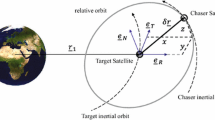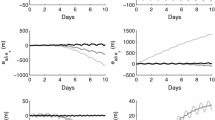Abstract
While trajectory design for single satellite Earth observation missions is usually performed by means of analytical and relatively simple models of orbital dynamics including the main perturbations for the considered cases, most literature on formation flying dynamics is devoted to control issues rather than mission design. This work aims at bridging the gap between mission requirements and relative dynamics in multi-platform missions by means of an analytical model that describes relative motion for satellites moving on near circular low Earth orbits. The development is based on the orbital parameters approach and both the cases of close and large formations are taken into account. Secular Earth oblateness effects are included in the derivation. Modeling accuracy, when compared to a nonlinear model with two body and J2 forces, is shown to be of the order of 0.1% of relative coordinates for timescales of hundreds of orbits. An example of formation design is briefly described shaping a two-satellite formation on the basis of geometric requirements for synthetic aperture radar interferometry.
Similar content being viewed by others
Abbreviations
- a:
-
Semi-major axis
- e:
-
Eccentricity
- i:
-
Inclination
- r:
-
Satellite distance from Earth center
- t:
-
Time
- u:
-
Argument of latitude
- x, y, z:
-
Hill’s reference frame of chief
- x|, y|, z| :
-
Reference frame centered in the chief with axes parallel to x||, y||, z||
- x||, y||, z|| :
-
Hill’s reference frame of the reference satellite
- D:
-
Subscript identifying deputy parameters
- M:
-
Mean anomaly
- MCH :
-
Transformation matrix from the chief geocentric reference frame to the Hill’s reference frame
- MDC :
-
Transformation matrix from the deputy geocentric reference frame to the chief geocentric reference frame
- X, Y, Z:
-
Geocentric inertial reference frame
- XC, YC, ZC :
-
Geocentric reference frame of the chief
- XD, YD, ZD :
-
Geocentric reference frame of the deputy
- α :
-
Rotation angle between x, y, z and x|, y|, z| around z ≡ z|
- δ :
-
Variation of parameters between deputy and chief when the latter is on elliptical orbit
- ν :
-
True anomaly
- ω :
-
Argument of perigee
- Δ:
-
Variation of parameters between deputy and chief when the latter is on circular orbit and between chief/deputy and the reference satellite when chief is on elliptical orbit
- \({\vartheta}\) :
-
Radar viewing angle (off-nadir angle)
- Ω:
-
Right ascension of the ascending node
References
Bamler R., Hartl P.: Synthetic aperture radar interferometry. Inverse Probl. 14, R1–R54 (1998)
Carter T.E.: State transition matrices for terminal Rendezvous studies: brief survey and new examples. AIAA J. Guid. Control Dyn. 21(1), 148–155 (1998)
Chobotov, V.A. (eds): Orbital Mechanics (3rd edn.). AIAA, Reston (2002)
Clohessy W.H., Wiltshire R.S.: Terminal guidance for satellite rendezvous. J. Aerosp. Sci. 27, 653–658 (1960)
Gens R., van Genderen J.L.: SAR interferometry-issues, techniques applications. Int. J. Remote Sens. 17, 1803–1835 (1996)
Gim D.-W., Alfriend K.T.: State transition matrix of relative motion for the perturbed noncircular reference. AIAA J. Guid. Control Dyn. 26(6), 956–971 (2003)
Gim D.-W., Alfriend K.T.: Satellite relative motion using differential equinoctial elements. Celest. Mech. Dyn. Astron. 92(4), 295–336 (2005)
Halsall M., Palmer P.L.: Modelling natural formations of LEO satellites. Celest. Mech. Dyn. Astron. 99(2), 105–127 (2007)
Hill G.W.: Researches in the Lunar theory. Am. J. Math. 1(1), 5–26 (1878)
Krieger G., Moreira A.: Spaceborne bi- and multistatic SAR: potential and challenges. IEE Proc. Radar Sonar Navig. 153(3), 184–198 (2006)
Lovell, T.A., Tragesser, S.G.: Guidance for relative motion of low earth orbit spacecraft based on relative orbit elements. AIAA Paper 2004-4988, AAS/AIAA astrodynamics specialist conference, Providence, RI, 16–19 Aug 2004
Moccia A., Fasano G.: Analysis of spaceborne tandem configurations for complementing COSMO with SAR interferometry. EURASIP J. Appl. Signal Process. 20, 3304–3315 (2005)
Sabol C., Burns R., McLaughlin C.A.: Satellite formation flying design and evolution. AIAA J. Spacecr. Rockets 38(2), 270–278 (2001)
Schaub H.: Relative orbit geometry through classical orbit element differences. AIAA J. Guid. Control Dyn. 27(5), 839–848 (2004)
Schaub H., Alfriend K.T.: J2 invariant orbits for spacecraft formations. Celest. Mech. Dyn. Astron. 79, 77–95 (2001)
Schaub H., Vadali S.R., Alfriend K.T.: Spacecraft formation flying control using mean orbit elements. J. Astronaut. Sci. 48(1), 69–87 (2000)
Schweighart S., Sedwick R.: High fidelity linearized J2 model for satellite formation flight. AIAA J. Guid. Control Dyn. 25(6), 1073–1080 (2002)
Sengupta P., Vadali S.R., Alfriend K.T.: Second order state transition for relative motion near perturbed, elliptic orbits. Celest. Mech. Dyn. Astron. 97(2), 101–129 (2007)
Vadali, S.R., Alfriend, K.T., Vaddi, S.: Hill’s equations, mean orbit elements, and formation flying of satellites. The Richard H. Battin astrodynamics conference, College Station, TX, March 2000
Wiesel W.E.: Relative satellite motion about an oblate planet. AIAA J. Guid. Control Dyn. 25(4), 776–785 (2002)
Author information
Authors and Affiliations
Corresponding author
Rights and permissions
About this article
Cite this article
Fasano, G., D’Errico, M. Modeling orbital relative motion to enable formation design from application requirements. Celest Mech Dyn Astr 105, 113–139 (2009). https://doi.org/10.1007/s10569-009-9230-5
Received:
Revised:
Accepted:
Published:
Issue Date:
DOI: https://doi.org/10.1007/s10569-009-9230-5




